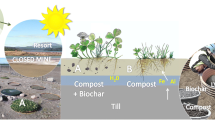Abstract
Quartz-sand tailings is a waste product from the Florida phosphate mining industry. Individual tailings disposal areas may occupy 20 to 60 ha and support no vegetation. A split plot field experiment was conducted on a sand tailings deposit to study the effect of various amendments on yield, quality, and mineral concentrations of ‘Callie’ bermudagrass (Cynodon dactylon var.aridus Harlan et de Wet) and ‘Siratro’ [Macroptilium atropurpureum (DC) Urb]. The two species were established on nine treatments: one sand-tailings control (SC); three with air-dried phosphatic clay (PC) at 110, 225, and 340 Mg ha-1; and three with overburden (OB) at 448, 1,120, and 1,800 Mg ha-1. All PC and OB treatment rates contained air-dried sewage sludge (SS) at 45 Mg ha-1 and were all roto-tilled to a 20 to 25 cm depth. There were two additional treatments of OB at 1800 Mg ha-1 without SS, with and without roto-tilling into sand tailings. Callie established slower (P<0.05) on SC and OB, than on treatments containing SS and/or PC. However, after the root system developed, yields were similar on all sand-tailings treatments. Crude protein andin vitro organic matter digestion for Callie and Siratro did not differ between soil treatments, but Siratro was generally superior to Callie in forage quality. Forage concentrations of P, K, Ca. Mg, Mn, and Zn were adequate in both species for good cattle growth on all treatments. However, Cu tended to be low in Siratro for plant and cattle growth. Once root systems were well established, good yields of quality forage with suitable mineral concentrations were produced on regularly fertilized, quartz-sand tailings.
Similar content being viewed by others
References
Zellars, M.E., and J.M. Williams, 1978. Evaluation of the phosphate deposits of Florida using the mineral availability system. Final Report. U.S. Dep. of Interior, Bureau of Mines, Pittsburgh. Pa. Contract no. JO 377000. 196 pp.
Farmer, E.E., and W.G. Blue, 1978. Reclamation of lands mined for phosphate, p. 585–608.In F.W. Shaller and P. Sutton (ed.) Reclamation of drastically disturbed lands. Am. Soc. of Agron., Madison, Wis.
Hortenstine, C.C., and D.F. Rothwell, 1972. Use of municipal compost in reclamation of phosphate-mining sand tailings. J. Environ. Qual. 1:415–418.
Mislevy, P., and W.G. Blue, 1981. Reclamation of quartz sand-tailings from phosphate mining: I Tropical forage grasses. J. Environ. Qual. 10:449–453.
Mislevy, P.. W.G. Blue, and J.B. Brolmann, 1981. Reclamation of quartz sand-tailings from phosphate mining: II Forage legumes. J. Environ. Qual. 10:453–456.
Calhoun, F.G., V.W. Carlisle, R.E. Caldwell, L.W. Zelazny, L.C. Hammond, and H.L. Breland, 1974. Characterization data for selected Florida soils. Soil Sci. Res. Rep. no. 74-1. Soil Sci. Dep. Univ. of Florida Soil Characterization Lab., and Soil Conservation Service, USDA. University of Florida, Gainesville.
Moore, J.E., G.O. Mott. D.G. Dunham, and R.W. Omer, 1972. Large capacity in vitro OM digestion procedure. J. Anim. Sci. 35(1):232. Abstr. no. 261.
Gallaher, R.N., C.O. Weldon, and F.C. Boswell, 1976. Semi-automated procedure for total nitrogen in plant and soil samples. Soil Sci. Soc. Am. Proc. 40:887–889.
Walkley, A. 1947. A critical examination of a rapid method for determining organic carbon in soils. Soil Sci. 63:251–264.
National Research Council. Committee on Animal Nutrition. 1976. Nutrient requirements for beef cattle. No. 4, 5th ed. Natl. Academy of Sciences, Washington, D.C. 56 pp.
Mislevy, P.C.L. Dantzman. J.W. Prevatt, A.J. Overman, G.M.J. Horton, and F.A. Johnson, 1982. Forage production and utilization from a south Florida multicropping system. Univ. of Fla. Bull. 830. 39 pp.
Author information
Authors and Affiliations
Additional information
Contribution of the University of Florida Agric. Res. and Ed. Ctr., Ona, FL 33865, and Soil Sci. Dept., Univ. of Florida, Gainesville, FL 32611 as Journal Series No. 5575.
Rights and permissions
About this article
Cite this article
Mislevy, P., Blue, W.G. Forage production and quality as influenced by amended quartz sand-tailings following phosphate mining. Environ Geochem Health 7, 36–41 (1985). https://doi.org/10.1007/BF01875049
Issue Date:
DOI: https://doi.org/10.1007/BF01875049




